Season 9 has ended
The Insurance Apprentice 2023
Season 9 has ended
And so the season comes to a glittering conclusion.
Congratulations to Christopher Appanah from Bryte Insurance who was crowned the winner of the 2023 season.
It’s not an easy task finding the champion of the South African insurance industry. You have to sift through hundreds of applications to narrow the search down to a top 30 and that’s really where the real contest starts. This was the first year where we opted to film the elimination round. This meant getting our top thirty candidates into one room so they could battle it out for a coveted top ten spot. Our friends at Discovery Insure sponsored the event and provided a great backdrop for the tasks which resembled “The Amazing Race” with contestants dashing around the building, solving problems like Hercule Poirot on RedBull-infused Espresso. As the regular judges, Nox Dlamini and I don’t get to attend the elimination rounds normally, so I found it throughly entertaining when the episode aired at the end of March 2023. A highlight for me was the way Mpho “Sales” Machola choked during his presentation. His confidence and effervescent personality wasn’t enough to get him into the top ten but he did get a special mention at the grand finale last week. Check out this interview I did with him a few weeks ago.
Once we’d picked the top ten, the competition kicked into high gear with some of the toughest tasks we’ve seen in the competition since its inception 9 years ago. Old Mutual Insure sponsored a beautiful studio once again, at their offices in Sandton in Johannesburg. This was to be our home for the next five tasks, all designed to rattle and challenge our young financial services hopefuls.
If you haven’t watched the season yet, check out the trailers in the links below, they’re just a few minutes each and will give you some idea of the challenges that were thrown at the finalists:
Episode 2 – Sponsored by SHA Risk Specialists – Alicia Narainsamy joined us and helped us build up the pressure as a very agitated board of directors grilled the contestants after a cyber attack.
Episode 3 – Sponsored by SASRIA – Muzi Dladla joined our judging panel as we challenged the teams to come up with sustainable solutions for systemic risks.
Episode 4 – Sponsored by The Insurance Crime Bureau – Garth de Klerk sat with us at the judges’ table as we pressed the contestants to think about collaboration in the insurance market to tackle cross-carrier fraud.
Episode 5 – Sponsored by Marsh – Shivan Hutton brought some heat onto the contestants, challenging them with a climate change inspired task.
Episode 6 – Sponsored by the Financial Sector Conduct Authority – The remaining contestants had to really dig deep on this final task as corporate culture came under the spotlight. Farzana Badat joined us from the regulator on the judging panel.
It’s an immense honour to be asked back every year to be a judge in this competition. Someone asked me at the finale event how I can be so brutal and direct with the contestants. It’s not easy actually, my own personality is way more agreeable than “Judge Dread” (that’s what the contestants call me). I had to base this character on every horrible boss and upset client I’ve ever come across. I think that’s important to acknowledge because those were real people which means the contestants are quite likely to meet tough characters in real life. Those could be members of the press, colleagues or even clients. One can forget about getting a patient, pleasant and affable client in front of you if they’ve just been attacked by cyber criminals, and you’ve just told them they don’t have any cover.
When you’re watching the show at home it’s really easy to forget that there are cameras all around us but that really does heap another layer of angst onto the contestants. At first they are all a bit shaky and self conscious but then something miraculous happens with each challenge. This is perhaps the thing I love most about the competition. It’s all about witnessing the growth happening to individuals. In real life, such growth is often imperceptible, the tyranny of our inboxes and our busy-ness in our businesses means we can’t actually watch the development happen. This is my privilege as the head judge on The Insurance Apprentice.
To all the contestants that have the courage to enter each year, I tip my hat to you. And if you’re someone who hasn’t yet entered but are sitting on the fence – know that this is not an easy thing to do but it is absolutely worth it. If it doesn’t help you in your career (which would be a surprising and practically impossible outcome), you will grow as a person and will build special bonds with people that will last a lifetime. I hope to see you in front of my judges desk next year. Stop thinking about it. Just do it.
What’s the password?
What's the password?
Managing the unmanageable
How easy is it actually for a criminal to figure out your online passwords and how can you stop this from happening? In this week’s blog I’ll unpack my own personal journey of password purification. Welcome to part 2 of the series around personal cyber security. My friends at the SA Insurance Crime Bureau (https://www.saicb.co.za) published this wonderful graphic last year to explain how easy it is for criminals to figure out your password.
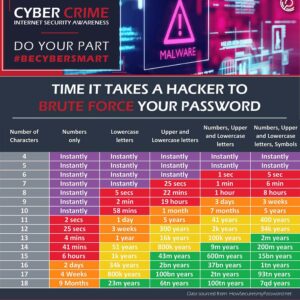
In other words, if you have a password with less than 10 characters, without combining numbers, letters and symbols, you might as well just post the password on your social media pages along with your bank statements. Someone asked me in a talk I was doing a few weeks ago, “Tell me oh wise LiabilityGuy, how is it possible that a ten-digit password can be cracked so quickly?” They may not have said it exactly like that but actually it’s not as simple as hackers just letting a super computer program run, inputting millions of combinations although the technology is definitely available. This is because most, well-maintained websites will generally have lockout features so after a few guesses, the user will be prevented from more than say, 5 consecutive incorrect guesses.
So if the hacker only has 5 guesses at time to try a possible 10 billion combinations it would take a lifetime to derive the key. That is of course if the hackers were simply trying to access the database through the front-end login page. Incidentally, since I posted my previous article about my attempted hack a few weeks ago, there have been almost 1300 brute force attacks on this site. Those are attackers trying to guess my administration password.
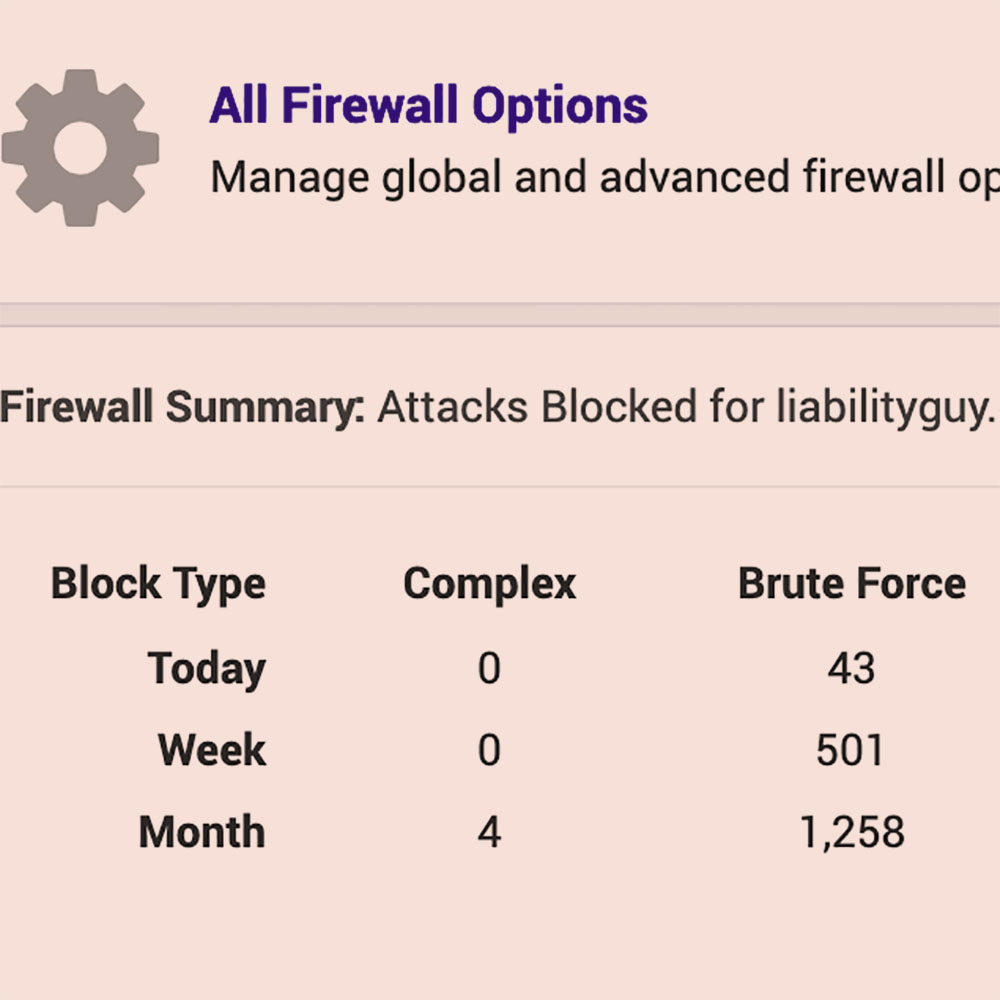
It is quite unrealistic to expect that hackers will try millions of passwords, waiting between lockouts, to get into a site. That’s like buying one cigarette at a time after each lockdown. Whenever you read about large-scale hacks, what has almost always happened is that hackers have stolen the entire database and then will use automated tools offline to “guess” the passwords in a copied database. Working offline they have as much time as they need to crack your well thought out password and username combo.
This brings me to the real reason for my blog. You see having a well-structured, complex password is only half the battle. Making sure that once it has been cracked, that it can’t be used in multiple attacks on other sites is the other half. If you reuse your password on many other sites, those brute force attacks become so much easier for the cyber criminals.
Credential re-use is a huge problem amongst internet users. Depending on which survey you look at, the range of lazy internet users who reuse their passwords is anywhere from 50% to 65%. Surprisingly a study done by DataProt in February 2021 showed that Gen Z users (age 16 to 24) are the biggest culprits with well over 70% using the same password and user combos across multiple sites.
The reason why we do this is simple, or rather it’s our need for simplicity that drives this reckless behaviour.
Even though I have some knowledge of cyber risk, I too have been guilty of this. In fact up until recently I would say that I was a habitual password regurgitator. I wonder if there is a support group for us? Fortunately this habit came to an end late in 2020 when I received one of those dreaded heads-up messages from Google to say the password I use on my account had turned up in one of the recent hack attacks.

This was the push that I needed to rethink my approach to my own cyber risk management. That inspirational moment was quickly followed by massive dread – how the hell would I remember which sites I have signed into over the years, let alone change the passwords?
A little LiabilityGuy disclaimer: I haven’t tried many methods but the one described below is working for me. If by the time you read this, I have subsequently been hacked…delete my profile from your memory and buy a typewriter and a telefax machine.
- If you use Mac OS then chances are you’ve allowed Safari to store your passwords in your keychain. You’ll have to sign into the Keychain with your mac password to see the list of sites and the user name, password combos. This was the category I was in.
- If you use Firefox, Chrome, MS Edge or Internet Explorer you may have allowed your browser to store the passwords. Those can all be found by clicking on the settings in the browser and then going to the security and passwords section. Easy.
- If you use Internet Explorer may I suggest you seek help from a mental health professional and join the 21st century as soon as possible. Just kidding, there is actually a video here
- If you haven’t allowed your browser to store your passwords then the only option available to you is to mine through your old emails and search for account registration emails that have been sent over the years. Try using phrases like “account confirmation” or “registration email”. I also recommend drinking heavily if using this method.
Number 4 above is a very painful exercise but don’t let this deter you on your recovery journey from pathological password peddling. I had actually registered for many different online services over the past decade so I determined that all I really needed to do was focus on the ones I had used most frequently over the past few years. I figured that my credit cards expire every 3-4 years so that sort of data probably wouldn’t have much value on the older sites and I’d changed my physical address a few times in the longer time span. In other words, I perceived the risk as lower on those accounts and dismissed them.
I was pleasantly surprised that most of the password storage options in browsers these days do have features that allow you to generate unique random passwords, some will even tell you on which sites you have reused passwords. If you aren’t going to use a separate password manager app, these browser solutions may be enough for you to sleep at night.
For me, I just felt that having all my data sitting in the browser database (even if it is encrypted) didn’t feel like enough so I opted to use a standalone password manager app. There are many available online. If you want a list of the top ones you can check this site out.
After checking out the costs and features I settled on Last Pass – perhaps the term “Ease of Use” in the ranking, sold me on it. I haven’t tried the rest so please send me your thoughts if you choose another.
Once you have the list of sites and passwords you can load them into the password manager, then you have to visit each site and change the password to a more complex unique one generated by the app. Its a pain but less painful than having your identity, money or reputation stolen from you.
I think Password Managers are excellent because:
- You only need to remember 1 password. That’s the one you use when you start up your browser.
- You can set up multi-factor authentication to protect the password vault. So you can use your Google Authenticator or any of your other favourites.
- You can use the password manager to generate random, extremely difficult passwords.
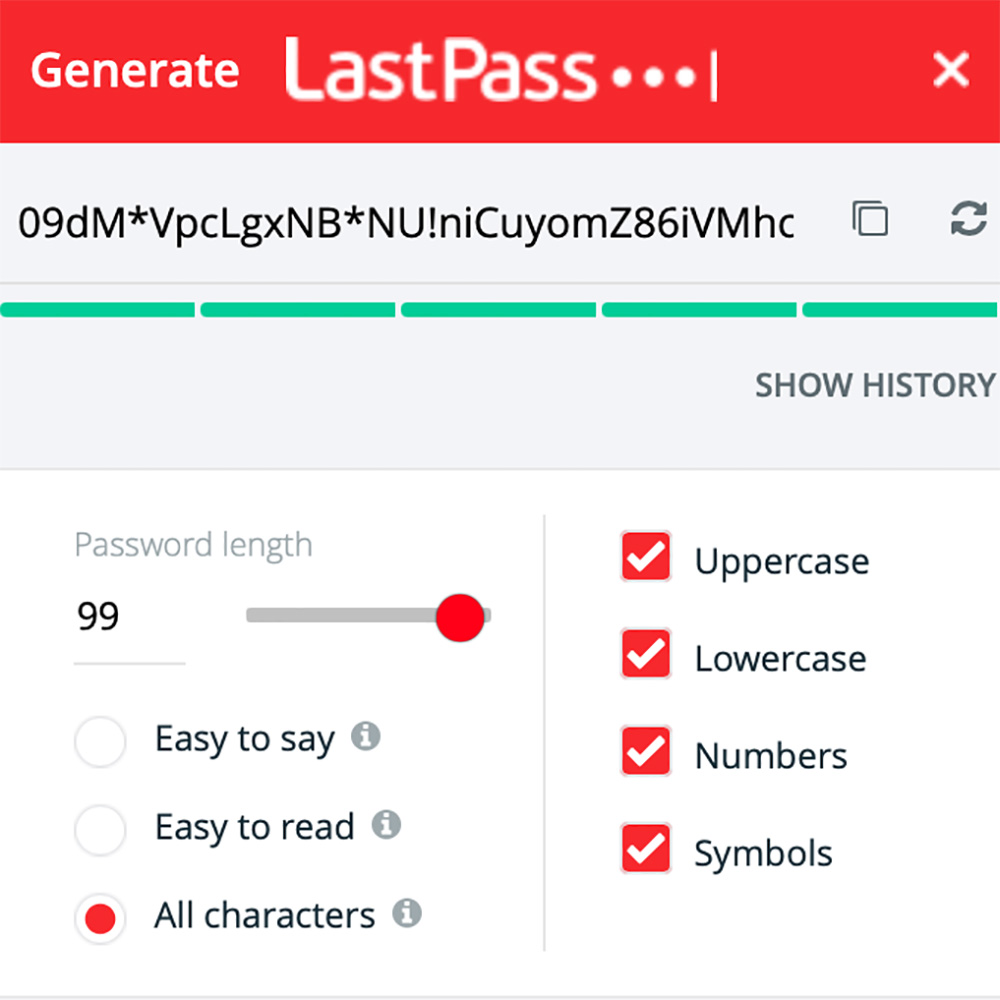
- They have dashboards that will alert you if any of your emails are compromised and appear on the dark web. Interestingly when I was doing this blog an alert came in today:
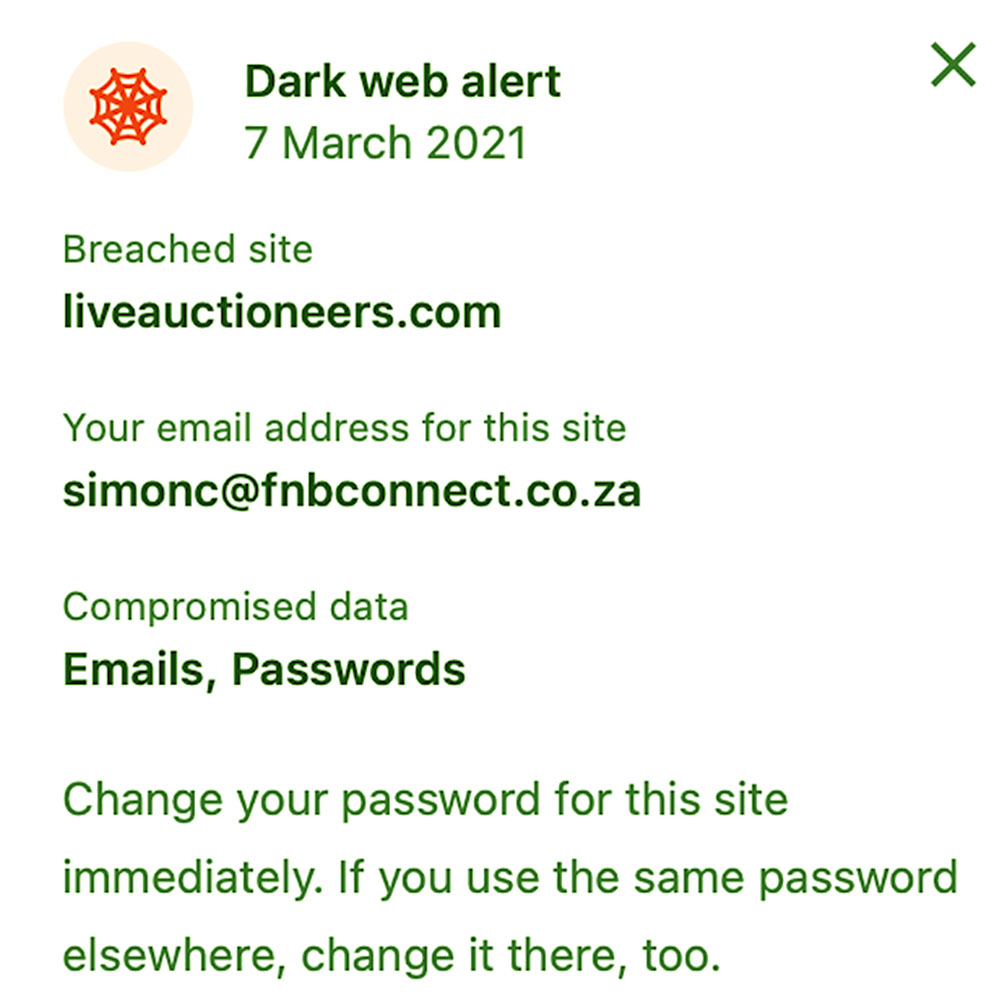
- You’ll be notified if you accidentally reuse your credentials again. You also get told if they are weak. Don’t take this personally. Just change them. Be strong.
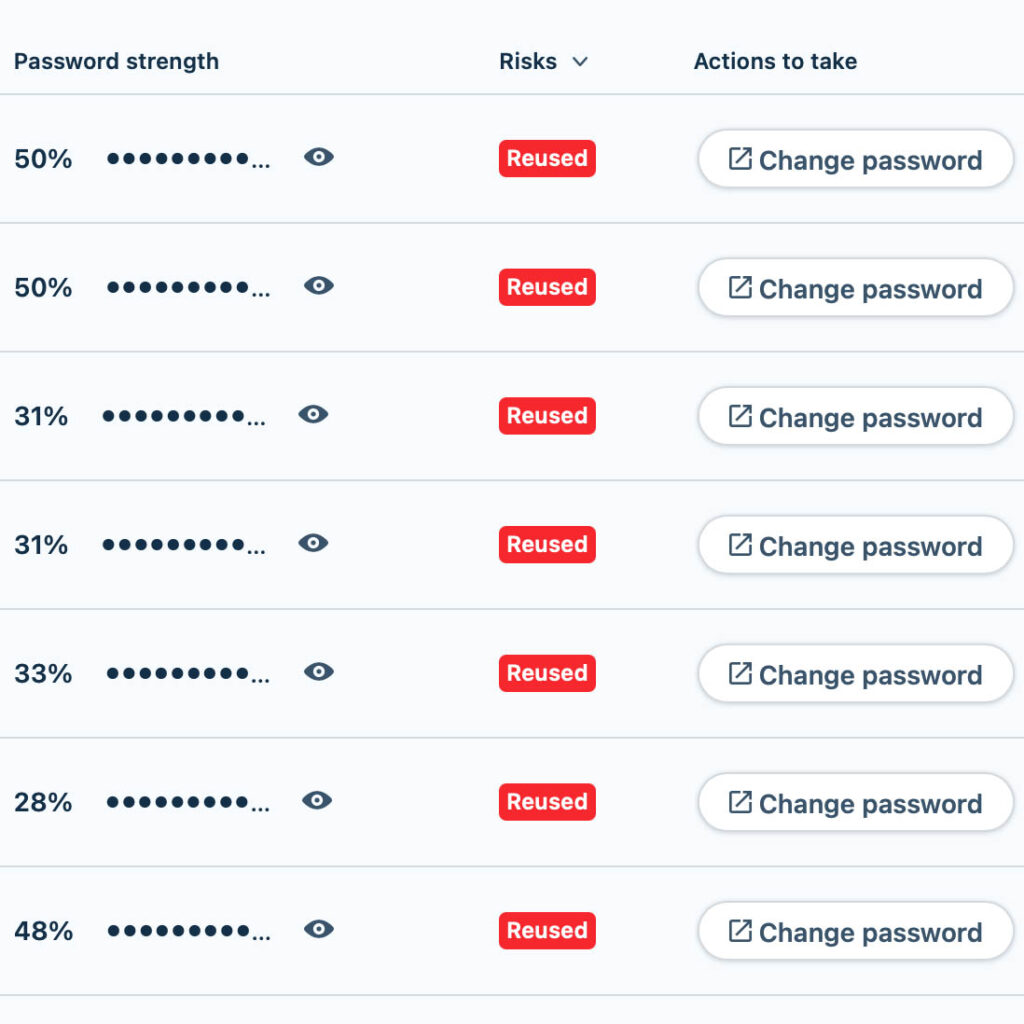
It hasn’t all been plain sailing. I started the project in December 2020 whilst on holiday but quickly realised that it’s a mind numbing exercise to change all my passwords. Rather than doing it in one sitting I resorted to changing the core sites first and then slowly added the others as I logged into them over the subsequent months.
I also discovered that you need to turn off the autofill features in your browser after you load the password manager otherwise, old passwords get entered by accident and you get locked out of whatever site you are trying to access. This actually happened on one of my bank accounts and I had to go verify myself in person but that’s a story for another day.
I’ve completed the process now and I’d still give LastPass 8 out of 10 and I do believe I’m safer online now than when I started the exercise.
I’m the LiabilityGuy.
This article was originally called “what’s the $**&%# P@55word?” but the URL kept bombing out.
Smile. You’re on Hacker TV
Smile. You're on hacker TV
Falling victim to sextortion scams
A few months ago I received an email from myself. Strange you may think to be sending mail to oneself? That’s what I thought too although perhaps more disturbing was the content of the mail. The email was from a hacker:
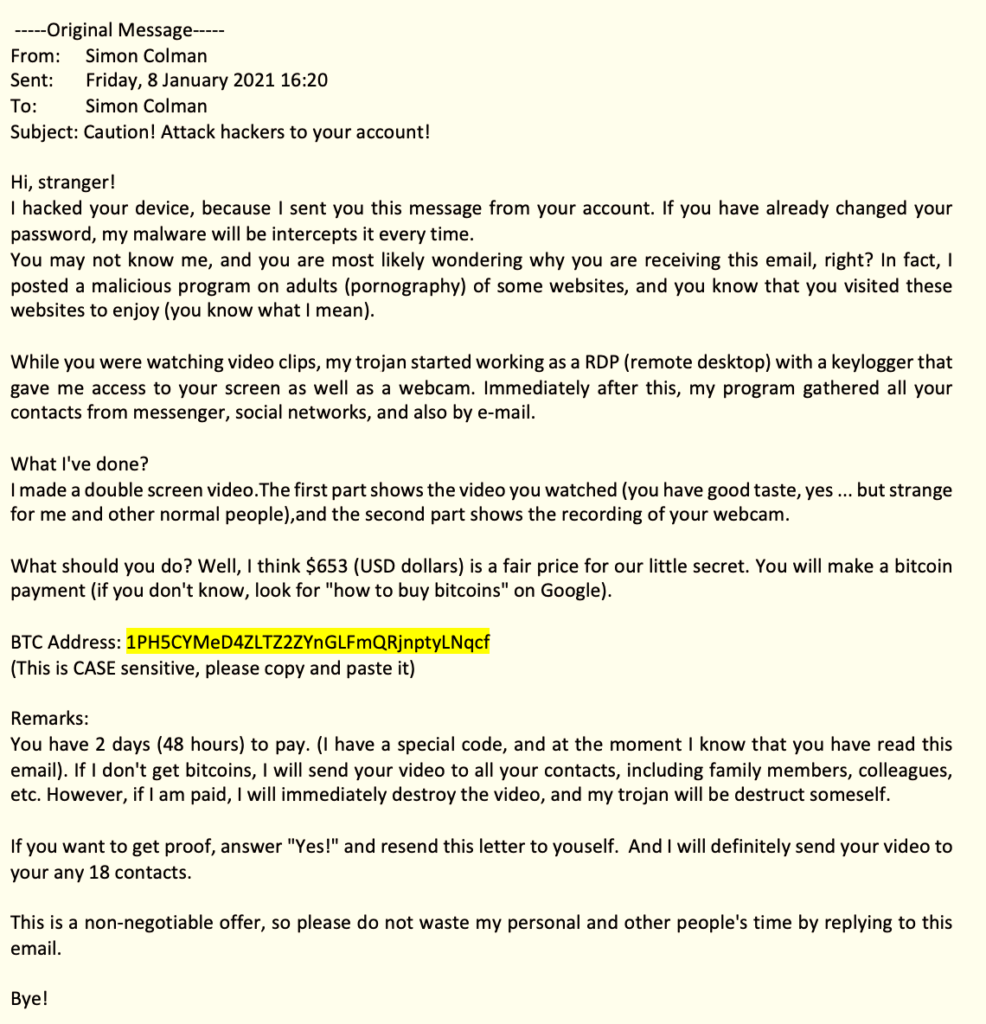
This talented social butterfly had purportedly gained access to my computer and had apparently recorded me whilst I was checking out some adult content. A split screen video had then been created with one half showing what I was viewing and the other showing me, well…scrolling with one hand I guess?
I apologise for the graphic imagery and let me help regain your composure by stating that this never happened. The email is real but the content had been carefully crafted to apply to a significant portion of the population. According to PornHub they have over 120 million daily viewers. Multiply that by the innumerable adult sites and you have an exponential number of potential targets for this particular email.
The scam relies on our overwhelming need to to preserve our dignity and to keep our internet browsing habits secret at all costs, or at least at the cost of $653.
I ran the bitcoin address through the Bitcoin Abuse Database and discovered that it had been reported 133 times and had accumulated 0.900351BTC which at todays rate is about R700,000 in 8 transactions. Now I don’t know how many of these emails were sent out but given the low work effort required to send emails, the return on investment is significant.
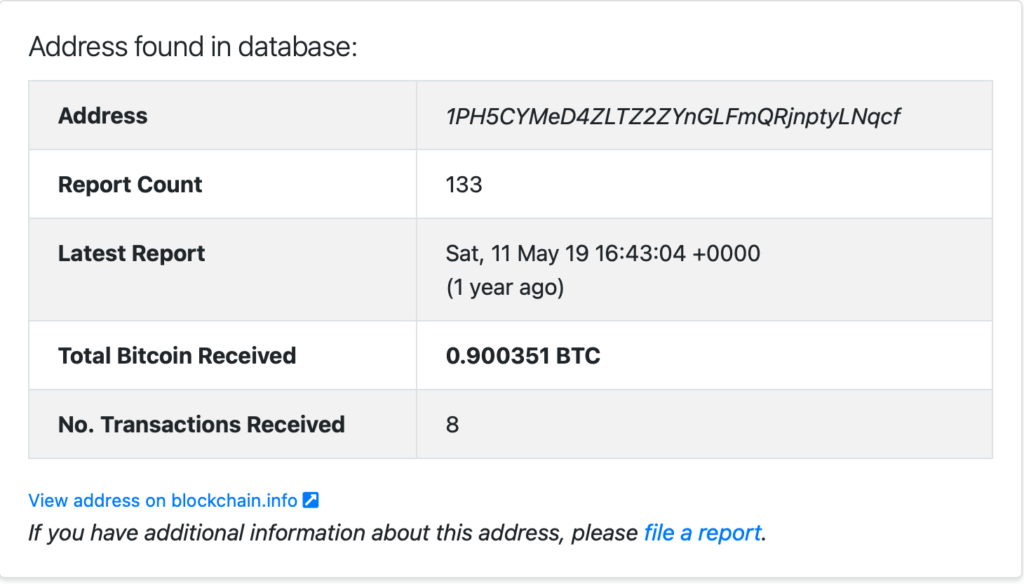
Would anyone actually pay? Well in this case 8 people actually did and you may wonder why? Is it a guilty conscience that drives this? I somehow doubt it. What is more likely is that some of these emails would contain your email address and perhaps a password that looks familiar. This convinces the victim that the hacker must have access to their computer or network. The coincidental viewing of adult content is just the kicker that pushes the hapless pornosseur over the edge to pay the ransom.
So where do the email and password combinations come from?
Every year hundreds of millions of emails and passwords are stolen in cyber breaches. In fact a week before I wrote this blog, it was reported by several cyber security sites that a database of 3.2 billion emails and passwords had been exposed on 2nd February. Its estimated that is around 70% of global internet users. It appears that this database is simply a compilation of stolen data from other breaches that have happened over past few years. It is in such data dumps that hackers obtain these valuable nuggets of information to either convince you that they have you inflagrante delicto or to hack into your other accounts.
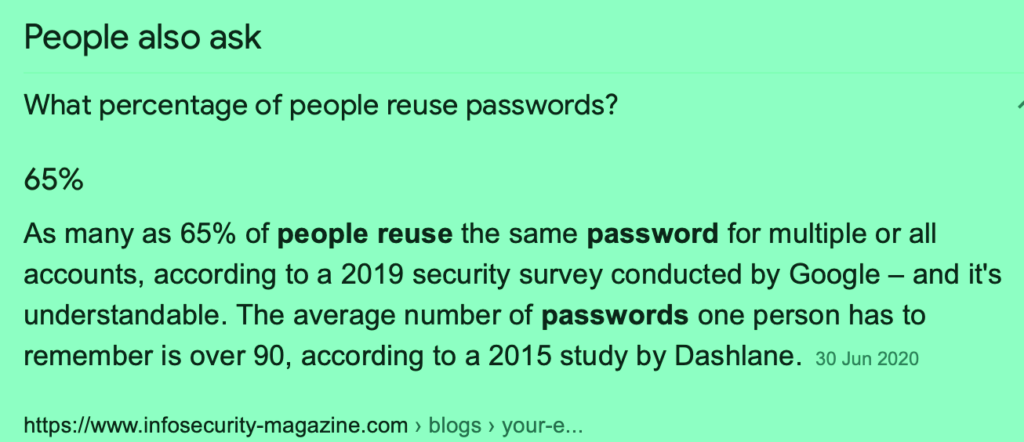
In a 2019 Google Survey, it was estimated that over 65% of internet users, use the same password on multiple accounts. Don’t do that or you’ll find yourself the victim of something far more sinister and serious than the sextortion scam I’ve spoken about here today. Try not to watch porn either.
If you do re-use your credentials as I have before, in the next edition I’ll be sharing my experience tightening up on my own personal cyber security and making the leap to unique and complicated password management. The easy way.
I’m the LiabilityGuy.
The dirty business of directors’ liability
The dirty business of directors' liability
A discussion about D&O Insurance
Last week was a blur, I spent three days on the road with the Insurance Bootcamp folks. We’ve done Cape Town, Durban and Joburg and now I’m sitting in my hotel room, massively inspired to write a little something of this grand adventure.

Firstly let me clarify that Insurance Bootcamp has nothing to do with physical exercise. Nor does it involve brokers in a race to pilfer each other’s clients, nor is it a wrestling match between underwriters as they try to beat each other into submission with rate cuts. In fact, it mostly involves chugging down coffee and baked goods whilst spewing forth great wisdom about the mysteries of the world’s second oldest profession. This particular Bootcamp focused on the ever-expanding mountain of litigation risks facing business owners.
As such financio-legal wisdom is not easy to come by (I do believe I just created that fantastic term by the way. Readers may use it as they wish without fear of copyright reprisal). Anyway, forgive the digression but any notion that I may have possessed this peculiar combo of financial services and legal knowledge was quickly shattered when an obviously impressed delegate, who was clearly paying attention to my slides, complimented me on my choice of socks. Herewith a photo of day 1, 2 and 3 socks for your information.

Aside from a clear demonstration of superior taste in footwear I’d been asked to share some of my experiences with some oft misunderstood areas of liability business namely, Professional Indemnity (PI) and Directors & Officers Liability (D&O). Who names these products by the way? You’d think that given the flexibility of acronyms, that a bit more creativity would’ve been applied. For example, the latter could have been named Derivative Indemnity Liability – Directors & Officers, also known as DILDO. Just think of the possibilities. Upon being appointed to the board, a director could state, “there’s no way I’m exposing my ass unless you get me a DILDO” or ” go ahead and sue me, I’ve got a DILDO and I know how to use it”
Given that there may be readers of this blog who are not in the insurance industry and whom are possibly sensitive to the use of the DILDO, I shall revert to the original D&O.
So what is it then? It’s a legal defence and damages policy invented by Lloyd’s back in 1930, probably as a consequence of the Great Depression. Someone felt it was a good idea to insure the directors just before they threw themselves out of a high-rise window. After all what good would the embattled CEO be to a disgruntled shareholder when he was broke, both physically and financially.
Unlike the basement-diving, kamikaze directors of the time, the cover never really hit the ground, that is until the Americans got hold of it. Americans love liability policies as much as they love guns. Guns can also be useful for solving shareholder disputes by the way. Cheaper than the D&O policy and you don’t have to provide a copy of your financials to get one.

So, many years later, this incredible piece of insurance wordsmithery found its way to the shores of our country. South Africa, the land of opportunity. The place where even the most corrupt of politicians can legally earn a living by fleecing honest folks out of their hard-earned cash. Fortunately D&O insurance is gaining popularity amongst private sector directors, because unlike their public sector counterparts, they are actually held accountable for their mistakes.
The policy really is a “must-have” these days for all directors and business owners. Why, you ask? Why, oh wise liability guy with great socks?
Well, Directors and Officers liability insurance protects business leaders from litigation which may be initiated against them by stakeholders. A stakeholder, in the context of the Companies Act, is not a person wielding a large cut of beef, nor a fearless hunter digging up dirt and seeking out blood-sucking miscreants (although I’m told Thuli Madonsela is making excellent progress in her investigations these days). Actually a stakeholder could be any party that suffers a loss as a result of the negligent actions of the directors or officers in carrying out their fiduciary duties. The word fiduciary it turns out is hysterically funny to my teenagers, who immediately identified the hidden colloquial term, “douche”. For those that don’t know, the word really refers to the high standard of care expected of directors, rather than a derogatory term that could be used to describe a politician.

A client of mine had the misfortune of going head to head with the National Consumer Commissioner a while ago. It’s ok to chat about this because neither of the protagonists in the tale subsequently retained their positions. The whole sordid debacle did however cost the CEO and the Company over R7m in legal fees. Fortunately the DILDO was close at hand and a large portion of the financial pain was taken care of by the insurers.
So it would appear that having this specialist insurance is a necessity and that every decision maker in the company should have the benefit of a policy. This, coupled with the relatively low premiums charged by insurers does mean that brokers are able to sell the cover with relative ease. Like selling firepools at a national security conference. Herein lies the danger for the insurance agent selling the cover. The temptation to spend less time explaining the cheaper covers to a potential insured is ever-present. Exclusions and notification requirements for D&O can be a little different to traditional policies. Given that the directors personal assets are at stake when a claim ensues, the risk of repudiation should be mitigated through careful explanation of cover with every client.
Sounds complicated? Herewith something simple for my fellow insurance intermediaries, for free:
The Liability Guy’s Theory of Relativity, “The amount of commission derived from the sale of D&O is inversely proportional to the amount of shit coming your way, if you make a mistake.”
In all seriousness, hats off to the Risk SA guys and all involved with Insurance Bootcamp. Great to be a part of the event.
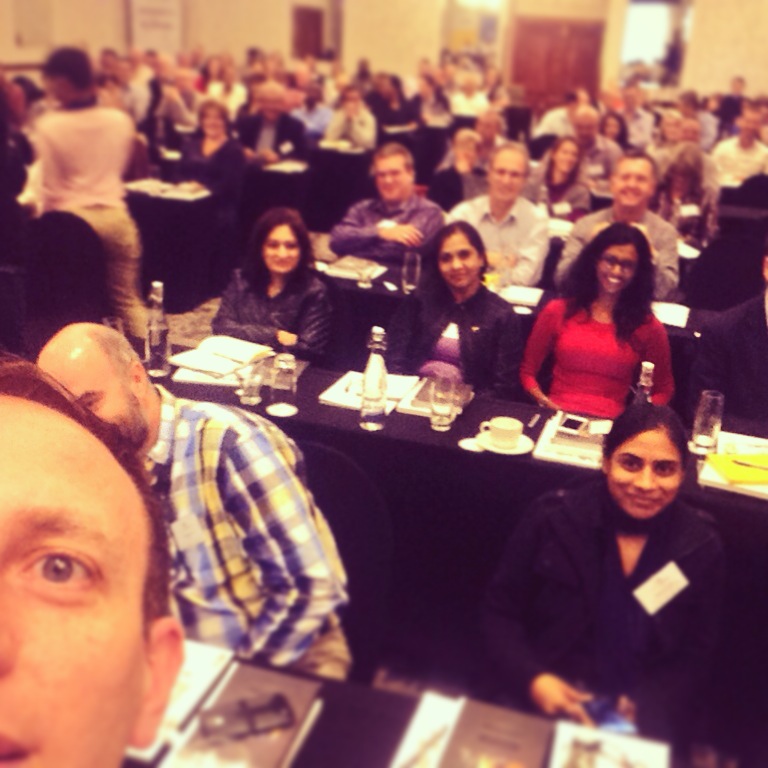
I’m the Liability Guy, take care.
What the hell is a liability anyway?
What the hell is a liability anyway?
And should you care?
Setting fire to the neighbours property, kids bouncing off jumping castles, cosmetics that burn your face off…. What the hell is a liability? Who the heck is a third party? Whatever happened to the second party? These and other conundrums solved in the first blog in a series that demystifies my world of liabilities.
A lot of people ask me what on earth a liability actually is? If you’re an accountant, too much liability is not a good thing. In the financial world a liability is the other side of the balance sheet; the dark and scary side that keeps you up at night. For many South Africans it’s the only side of the balance sheet unfortunately. Debts and sacks of money owed to other people often make up the bulk of financial liabilities.
By now you are thinking, “I knew this blog was going to be crap, if I wanted to be reminded of my financial woes I’d check my shares in a certain furniture and clothing retailer” I know you are thinking this because as I am writing it, I too am contemplating a much needed root-canal treatment rather than completing the blog.
Fortunately the type of liability that I am involved with, has nothing to do with accounting. Sorry bean-counters, there’s no ledger-porn to see here. I am the Liability Guy and welcome to the wondrous world of legal liability. This you’ll soon find out is much more exciting because it is here that we deal with:
- Killer cosmetic compounds that want nothing more than to give your customer that permanently surprised, “where are my eyebrows?” look.
- Erratic and irresponsible employees that light up more than a cigarette in your client’s warehouse whilst having a sneaky fag in the no-smoking area.
- Clumsy customers who fall down the stairs in your shop because they’re more into WhatsApp than watching where they are going. If you break it, you buy it doesn’t count when the damaged goods are your client’s legs.
- Sugar spiked toddles on a such a high in that play area at your restaurant that they bounce right off the jumping castle and straight into Mrs. Mathebula celebrating her 80thbirthday. Maybe that’s why they call them off-spring?
You may be wondering what all these ridiculously, tragic scenarios have in common? Well the truth is they will all probably result in a lawsuit against the owner of the business. There is of course insurance that can cover these events and the source of claims against these policies are generally those that have resulted in injury or damage sustained by a mysterious group of people we call, “third parties”.
“A third party”, I see you raise both eyebrows. “I’m always up for a party, maybe even a second party but a third party? Will there be beer-pong, balloons, a cake or a cow on a spit? Three parties though. Who has that kind of staying power?” you may wonder.
Again, you’ve been misled, just like our accounting friends earlier in this article. The kind of third parties we talk about in liability insurance circles have nothing to do with people drinking and carrying on like teenagers, unless the business being sued is a bar. By the way, if you get drunk in a bar in some parts of the USA and cause an accident, the injured parties may actually sue the bartender for getting the driver drunk. True story, and similar things are on the cards in South Africa in proposed amendments to our own liquor laws. Did you see what I did with the word “parties” there?
The third parties we talk out in liability insurance are the hapless group of individuals (or even other businesses) who seem to have zero luck and are always on the receiving end of dangerous goods or poor services, inevitably leaving them out of pocket , injured or worse. We call them third parties because they are not a party to the insurance contract directly. The first party is the policyholder (the butcher, baker, candlestick maker or whomever had the foresight to buy the policy), the second party is generally accepted as the insurance company although you will never hear mention of the second party. We don’t ever talk about them. Are they are like the uncle who gets drunk at the family dinner and tries to get amorous with the garden gnome on the front lawn? Or are they the invisible heroes who want no credit for saving us from financial ruin? That I suppose depends on whether the claim gets paid…
In any event, this tale is not about the invisible second party. Just remember that the third party is the disgruntled, injured and often litigious individual who wants to take you to court. Unless you are a former president of a beautiful country at the tip of Africa, in which case a whole country may want to take you to court.
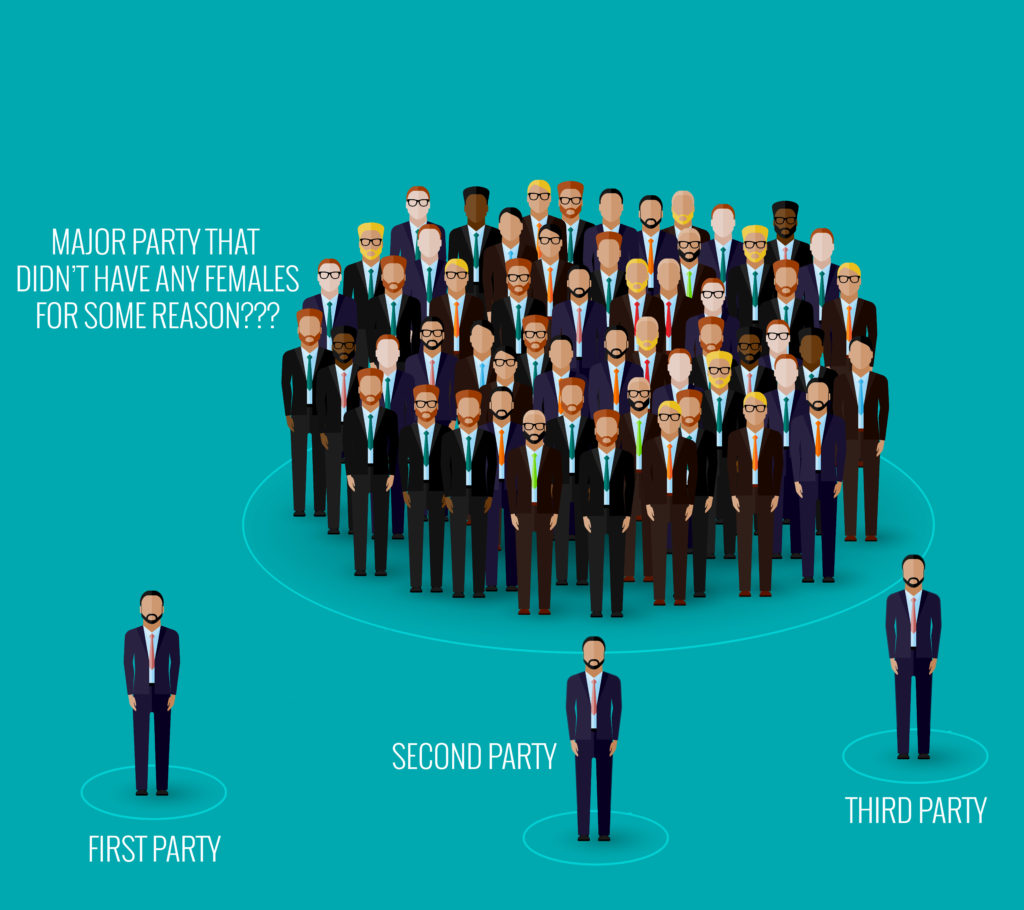
Don’t get me wrong, many third parties have good grounds for litigating and it is possible that the business actually did something to warrant being sued. Accidents do happen and someone is generally to blame when they do. If it’s not obvious whodunnit then both sides may have their day(s) in court. That’s generally where things get expensive and legal liabilities quickly start to turn into financial liabilities. Lawyers of the world rejoice. Accountants, you are back in play.
It’s these expensive processes in court and the fact that the business may have to compensate the injured third party that warrants buying liability insurance. This is also the primary reason why I have a job. So if you’re a broker, please sell more liability insurance.
Over the next few months I’ll be writing more about the wonders of liability so please be sure to follow this blog.
Note that as I am the LiabilityGuy I have to include a suitable disclaimer so please don’t treat any of these blogs as legal or financial advice. Be sure to chat to your broker if you’re a policyholder or if you’re a broker yourself, chat to your favourite insurance underwriter (follow my eyes) to get some detailed training or product information. The opinions expressed here are all my own, written in my personal capacity.
Related article on this blog : Coffee Cups, Ladders and Vibrators